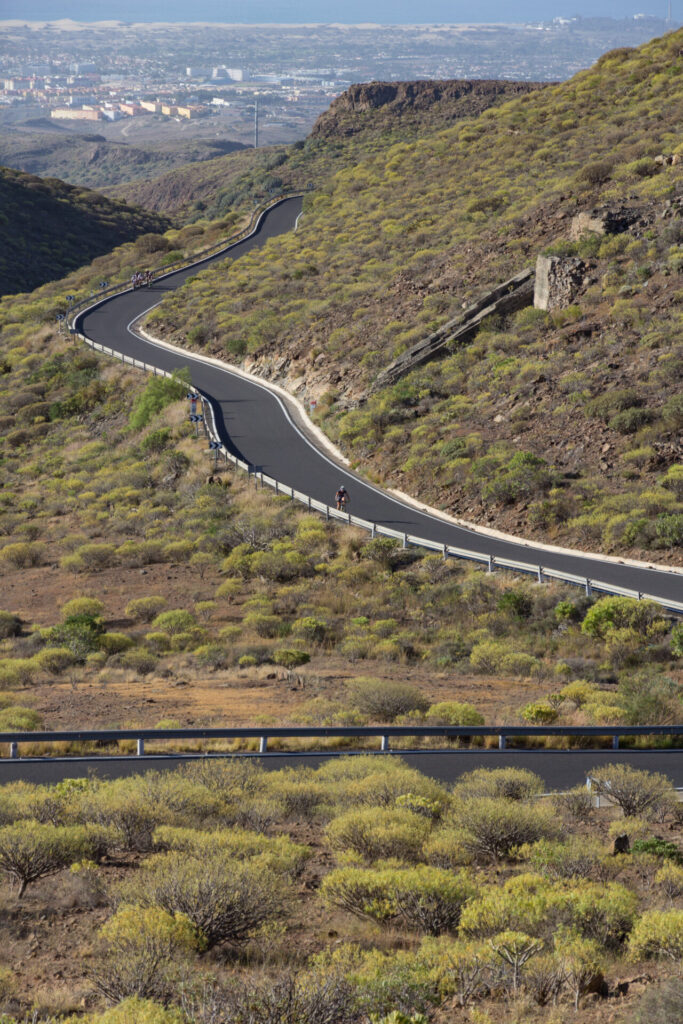As the days shorten and the evenings and nights get longer in the Netherlands, you have a number of options for still enjoying yourself on your bike. Of course, with the right equipment, you can cycle in the evening and at night, but that is not for everyone. Many then turn to alternatives like boot camp or training on the indoor trainer. With programmes such as Zwift, Rouvy and Bkool you come a long way, but nothing beats the outside. So where can you go decently in winter, without spending days on the road straight away? The go-to destination for many cyclists is the Canary Islands, especially Gran Canaria and Tenerife. We have a nice article for you about the winter destination: Gran Canaria. Enjoy!



Volcanic soil
Gran Canaria, like the neighbouring islands of Tenerife and La Palma, is mainly volcanic soil. There is also a (dormant) volcano on the island, Pico de las Nieves. Unlike Tenerife, where basically everything revolves around the magical and mighty 'El Teide', Gran Canaria is more versatile. In fact, not one metre is flat and, as such, even a short ride will soon satisfy you. The Pico de las Nieves is the highest point on the island. The road to it is one not soon to forget. But we'll come back to that later.
Read also:
Basecamp Maspalomas
It is always good to have a basecamp on an island like Gran Canaria. A place from which you can go in different directions and which is also a good base in terms of facilities. Now, you have several choices on the island. Of course, you can stay in Las Palmas, but this is a very busy city and to get from Las Palmas to the beautiful routes will take you some time on the road again. Of course, if you want to go on an altitude tour, you could go into the mountains, but then again you are stuck with the 'always ending with a climb'. We choose Maspalomas, in the south. From there you can do a nice island tour, there are several bike rental companies and you're near one of the most beautiful beaches, Playa del Inglés.
Tranendal
An absolute must-do on the island is to climb the 'Valley of Tears'. This route that runs along the GC-606 from the junction with the GC 210 to the climb up to the junction with the GC-60 is perhaps the most photographed spot in all of Gran Canaria. As such, it is not just any climb. For 12.4 kilometres you are buffeting uphill and the average gradient is 11.1%. Stelvio, eat your heart out. Another little tip from the experts: there is a stretch of about 100 metres that touches the 25%. Ouch. Not funny.
Valley of the Tears, Tejeda, Spain
- Distance: 10.6 km, Elevation gain: 976 m, Average grade: 9.5 %

Pico de las Nieves
Undeniably, the Pico de Las Nieves from Maspalomas the monster climb you really should always do on Gran Canaria. 44 kilometres long at 5.5% average. That second one doesn't sound that intense, but there are three sections in it that go downhill, as you can see on the altitude profile below. That means the rest of the climb is really going to hurt. At most, you'll encounter almost 12%. The somewhat flatter and descending sections mean you actually have four climbs in one, with the final section being just over 15 kilometres. Once at the top, you're at over 1900 metres, and if you look closely you can also see neighbouring island Tenerife and El Teide in the distance. Beautiful!
Pico de las Nieves, San Bartolomé De Tirajana, Spain
- Distance: 44.8 km, Elevation gain: 2005 m, Average grade: 5.5 %

Round the island
If you want to see the island from a completely different angle, a whole tour of the island is just over 200 kilometres in total. You will then ride almost 3800 altimeters, if you choose the most direct route. The route along the coast through the Parque Natural de Tamadaba is one to remember. Also take in the lighthouse at Punto de Sardina. The stretch from Las Palmas to the airport is a bit of a struggle, but then it becomes beautiful again. Pure enjoyment.
Gravelrides
Actually all Spanish islands, from Mallorca and Ibiza to Tenerife and Gran Canaria are suitable for graveling. The volcanic soil works wonders. Of course, they are also suitable for MTB and initially many of the routes were made for that. But with the rise and popularity of gravel, there is a lot of overlap. One of the most beautiful routes we still find is the 'cross island' route from Tamadaba to Tejeda. You pick up d ematest stretches and when you are on your way back, you go downhill. Find more great rides and routes here!

Road bike and off-road routes in Gran Canaria
Hotels and accommodation in Gran Canaria
Below is an overview and selection of hotels plus hotspots in Gran Canaria. Are you missing any? Then comment on this article and we'll add it!





